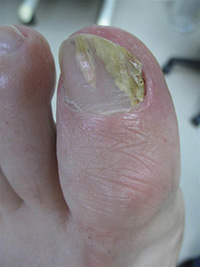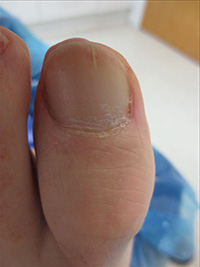Fungal Nail
What is a Fungal Nail Infection?
A Fungal Nail Infection occurs from the overgrowth of fungi in, under, or on the nail. Fungi thrive in warm, moist environments, so they are able to naturally overpopulate on our feet.
Why do I need treatment for Fungal Nail Infections?
How can you treat Fungal Nail Infections?
Fungal Nail Infections are diagnosed by our podiatrists who can provide the most appropriate course of treatment which may include nail lacquers and topical creams. If the infected nail edge is causing an ingrown toenail, we may perform a partial nail ablation (PNA) under local anesthetic to cure both problems. For longstanding infection, we may recommend the removal of the whole nail under a local anesthetic whilst treating the nail bed to kill the fungus.
If you have a fungal infection it is our aim to provide the very best care, give you the best chance to keep your feet looking great, enhance your mobility and keep you comfortable.
Frequently Asked Questions: Fungal Nail Infections
What is a fungal nail infection?
It’s an infection caused by fungal overgrowth in or under the nail. Fungi thrive in warm, moist environments — like sweaty socks and enclosed footwear — making our feet particularly vulnerable.
How do I know if I have a fungal nail infection?
Early signs include discolouration (usually yellow or white) near the tip of the nail, thickening, brittle or crumbling edges, and irritation around the nail plate. It often starts mild and worsens over time.
What causes it?
It’s often caused by trapped moisture, poor foot hygiene, nail trauma, or spread from athlete’s foot. Walking barefoot in communal areas like gyms and pools also increases your risk.
Is it contagious?
Yes. Fungal infections can spread between people and across your own toes or fingers if not treated properly. It’s best to avoid sharing socks, towels, or footwear while infected.
What treatments are available?
Treatments range from topical antifungal creams and lacquers to surgical removal of the nail. In cases where fungal nails cause pain or ingrown nails, a Partial Nail Ablation (PNA) may be recommended.
Can a fungal nail be cured?
Yes, but it may take time. Catching it early offers the best outcome. Severe or long-term infections may require more intensive intervention, including full nail removal and nail bed treatment.
Treatment Options for Fungal Nail Infections
| Treatment | When It’s Used | Provided by TFH? |
|---|---|---|
| Topical Antifungal Creams | Early or mild infection | ✔ |
| Antifungal Nail Lacquers | Moderate infections, non-invasive option | ✔ |
| Partial Nail Ablation (PNA) | When nail is ingrown or painful | ✔ |
| Full Nail Removal | Severe, longstanding fungal infection | ✔ |
| Nail Bed Treatment | To kill fungal spores and prevent recurrence | ✔ |
| Oral Antifungal Medication | Persistent infections, prescribed by GP | ✔ (via referral) |


